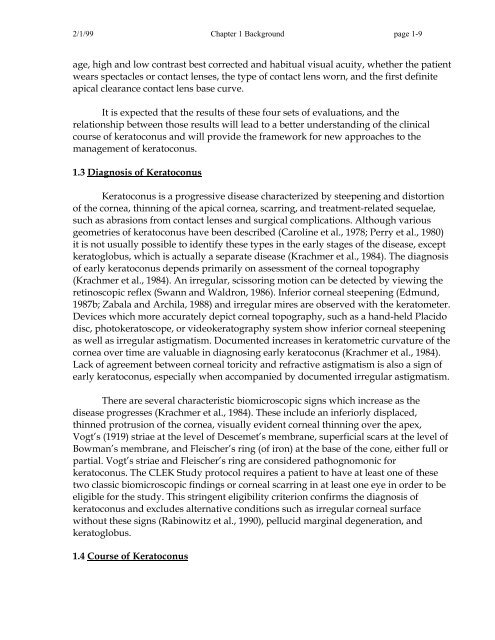OM t of c.iii - Vision Research Coordinating Center - Washington ...
OM t of c.iii - Vision Research Coordinating Center - Washington ...
OM t of c.iii - Vision Research Coordinating Center - Washington ...
You also want an ePaper? Increase the reach of your titles
YUMPU automatically turns print PDFs into web optimized ePapers that Google loves.
2/1/99 Chapter 1 Background page 1-9<br />
age, high and low contrast best corrected and habitual visual acuity, whether the patient<br />
wears spectacles or contact lenses, the type <strong>of</strong> contact lens worn, and the first definite<br />
apical clearance contact lens base curve.<br />
It is expected that the results <strong>of</strong> these four sets <strong>of</strong> evaluations, and the<br />
relationship between those results will lead to a better understanding <strong>of</strong> the clinical<br />
course <strong>of</strong> keratoconus and will provide the framework for new approaches to the<br />
management <strong>of</strong> keratoconus.<br />
1.3 Diagnosis <strong>of</strong> Keratoconus<br />
Keratoconus is a progressive disease characterized by steepening and distortion<br />
<strong>of</strong> the cornea, thinning <strong>of</strong> the apical cornea, scarring, and treatment-related sequelae,<br />
such as abrasions from contact lenses and surgical complications. Although various<br />
geometries <strong>of</strong> keratoconus have been described (Caroline et al., 1978; Perry et al., 1980)<br />
it is not usually possible to identify these types in the early stages <strong>of</strong> the disease, except<br />
keratoglobus, which is actually a separate disease (Krachmer et al., 1984). The diagnosis<br />
<strong>of</strong> early keratoconus depends primarily on assessment <strong>of</strong> the corneal topography<br />
(Krachmer et al., 1984). An irregular, scissoring motion can be detected by viewing the<br />
retinoscopic reflex (Swann and Waldron, 1986). Inferior corneal steepening (Edmund,<br />
1987b; Zabala and Archila, 1988) and irregular mires are observed with the keratometer.<br />
Devices which more accurately depict corneal topography, such as a hand-held Placido<br />
disc, photokeratoscope, or videokeratography system show inferior corneal steepening<br />
as well as irregular astigmatism. Documented increases in keratometric curvature <strong>of</strong> the<br />
cornea over time are valuable in diagnosing early keratoconus (Krachmer et al., 1984).<br />
Lack <strong>of</strong> agreement between corneal toricity and refractive astigmatism is also a sign <strong>of</strong><br />
early keratoconus, especially when accompanied by documented irregular astigmatism.<br />
There are several characteristic biomicroscopic signs which increase as the<br />
disease progresses (Krachmer et al., 1984). These include an inferiorly displaced,<br />
thinned protrusion <strong>of</strong> the cornea, visually evident corneal thinning over the apex,<br />
Vogt’s (1919) striae at the level <strong>of</strong> Descemet’s membrane, superficial scars at the level <strong>of</strong><br />
Bowman’s membrane, and Fleischer’s ring (<strong>of</strong> iron) at the base <strong>of</strong> the cone, either full or<br />
partial. Vogt’s striae and Fleischer’s ring are considered pathognomonic for<br />
keratoconus. The CLEK Study protocol requires a patient to have at least one <strong>of</strong> these<br />
two classic biomicroscopic findings or corneal scarring in at least one eye in order to be<br />
eligible for the study. This stringent eligibility criterion confirms the diagnosis <strong>of</strong><br />
keratoconus and excludes alternative conditions such as irregular corneal surface<br />
without these signs (Rabinowitz et al., 1990), pellucid marginal degeneration, and<br />
keratoglobus.<br />
1.4 Course <strong>of</strong> Keratoconus
















